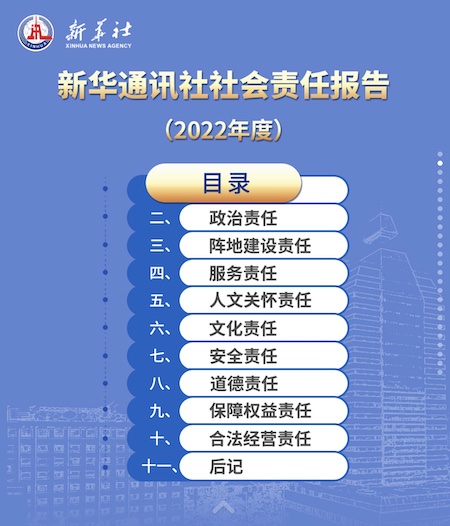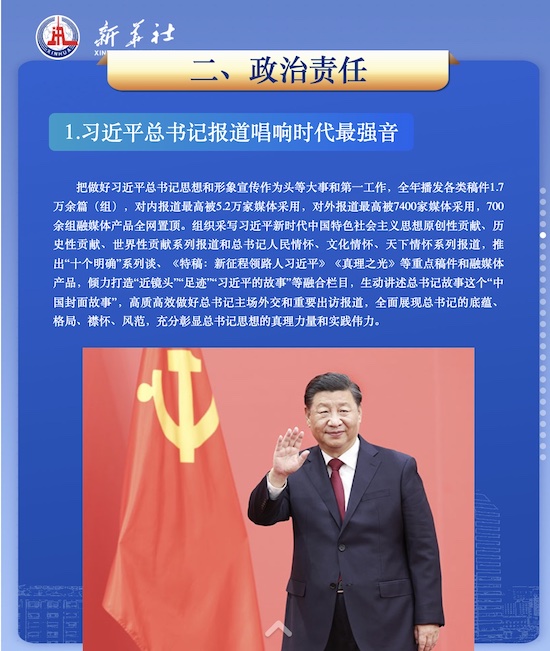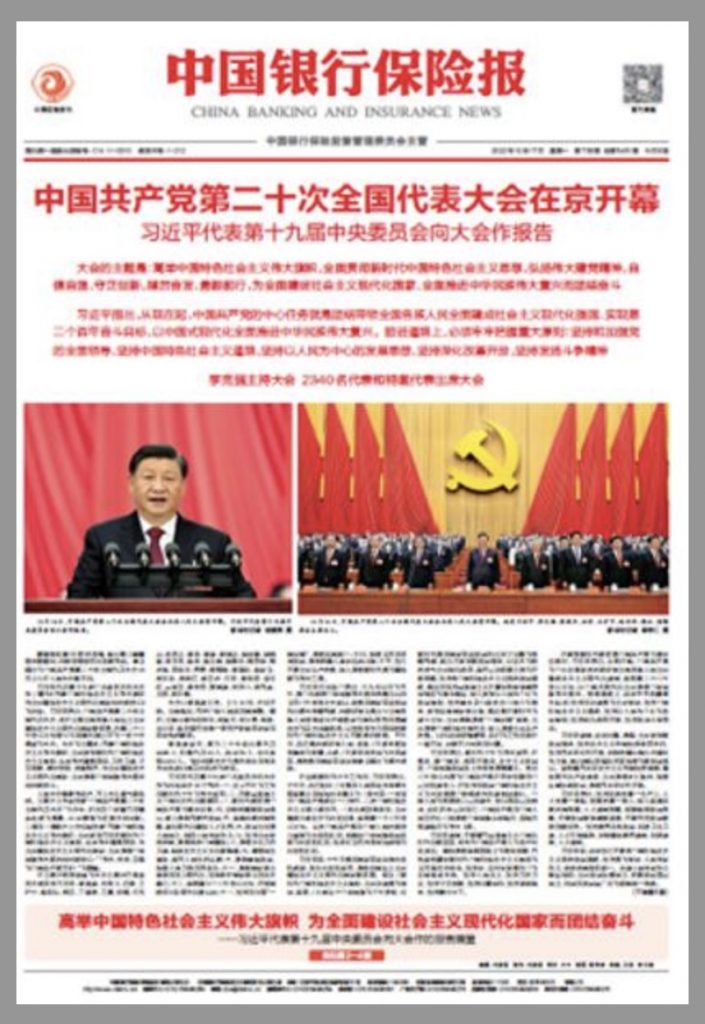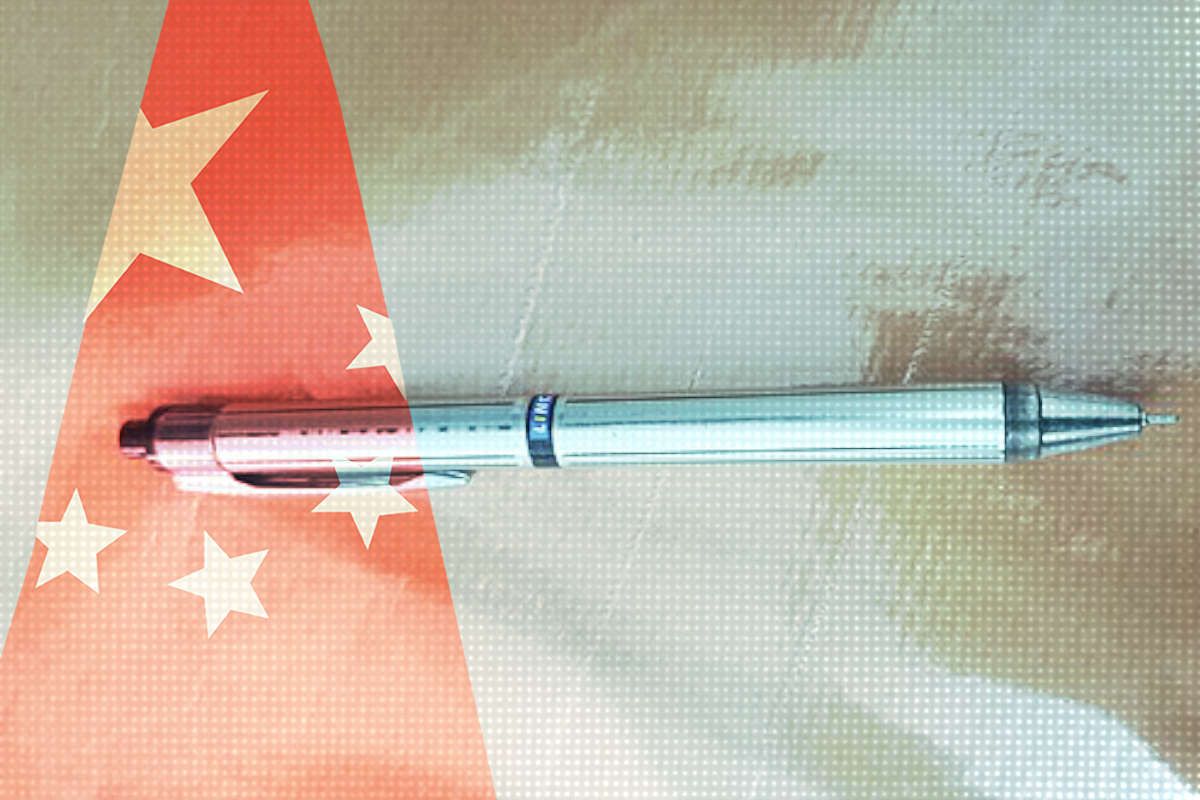Tracking Control
How to Please China’s Audience of One
Xi Jinping stands in the Great Hall of the People. Image from Flickr.com available under CC license.
This year marks the 10th anniversary in China of the annual “media social responsibility reporting system” (媒体社会责任报告制度), instituted at the start of the Xi Jinping era by the Central Propaganda Department (CPD) and the All-China Journalist’s Association. The system obligates media organizations to make annual self-assessments of their work in the interest of enforcing self-discipline.
While the nominal objective is “social responsibility,” the reports make clear that the primary duties of Chinese media are political in nature.
Begun on a trial basis in 2013, with the first reports appearing from a small number of media outlets the following year, the media social responsibility reporting system encompassed 40 media organizations by 2018, including six at the central level. In the latest reporting cycle, more than 500 media outlets from the central level down to the county level submitted social responsibility reports — more than 100 new outlets added since the last cycle.
The reports offer a revealing glimpse into the enforcement of political priorities in China’s official media, including commercially-run spin-off publications, and even a number of local “convergence media centers” (融媒体中心), which have in recent years supplanted party-state print and broadcasting outlets at the lowest levels. The chief message emerging from all of these reports is that social responsibility is a matter of political conformity.
Politics First
The Table of Contents of the social responsibility report released by Xinhua News Agency, a ministry-level agency directly under the State Council acting as the country’s official newswire, provides the basic line-up of priorities that is generally followed in responsibility assessments across the board.
When it comes to form, there is little room for creativity in these reports, most of which are archived online at the official website of the All-China Journalist’s Association, an ostensible professional organization whose primary role is not to represent media professionals but to regulate and control them.

The Table of Contents of Xinhua’s “Social Responsibility Report” 2022. Topping the list, “political responsibility.”
The preface first sets out the ideological positioning of Xinhua News Agency, and this section is virtually identical in all reports, regardless of the administrative level of the media outlet in question. Xinhua affirms that its work is led by the political thought of Xi Jinping, and by the “Two Establishes” (两个确立), the concept that defines Xi Jinping as the unquestionable “core” leader of the CCP, and his ideas as the Party’s bedrock.
Further, the preface affirms the principles of “Party spirit” (党性), and the Mao Zedong-era notion of “politicians running the newspapers” (政治家办报), essentially the notion that the CCP must directly control the media as opposed to allowing private outlets. This phrase, as we note in our CMP Dictionary, has made a dramatic comeback under Xi Jinping, and it is featured in all of the responsibility reports we reviewed (See the Nanfang Daily report here, for example).
Also of note are the mentions in the Xinhua preface of the need to maintain “guidance of public opinion” (again, media control), to “transmit China’s voice” (传播中国声音) — about the priority of external propaganda and the development of soft power — and to “propagate the Party’s ideas” (宣传党的主张).
The reports offer a revealing glimpse into the enforcement of political priorities in China’s official media, the chief message being that social responsibility is a matter of political conformity.
The preface makes the political nature — or, more accurately, Party nature — of Xinhua explicit from the start. The first section of the report that follows immediately after, called “Political Responsibility,” is the outlet’s opportunity to sound off about all of the good work it was done on the CCP’s behalf.
It is immediately clear that the top priority at Xinhua News Agency is the power and personality of Xi Jinping — and this is mirrored across the board in these responsibility reports. The first line of the section reads: “We took the proper handling of propaganda on the ideas and image of General Secretary Xi Jinping as our top matter of priority and our number one work.”

The news agency notes — this is an assessment, after all — that it published “more than 17,000 reports” altogether on Xi Jinping throughout the year, including domestic reports that were picked up 52,000 times by other media outlets inside China, and “external reports” (对外报道) that were picked up by 7,400 media outlets overseas.
Xinhua touts several special features and columns, such as “Xi Jinping, Leader on the New Path” (新征程领路人习近平) and “Xi Jinping Stories” (习近平的故事), all of which, according to the news agency, “fully demonstrated the truth power and practical greatness of the General Secretary’s thought.”
The “Political Responsibility” section also covers “major topical reports,” which is Xinhua’s opportunity to praise itself for going all-out on the major story of 2022, which of course was the 20th National Congress of the CCP, where Xi Jinping was handed a third term as general secretary.
Serve the Sheeple
Beyond the prescribed propaganda themes of Xi Jinping and the 20th National Congress, both foregone conclusions well before 2022 dawned, Xinhua congratulates itself on the role it played in “channeling public opinion” (舆论引导), a concept formally introduced by Hu Jintao in 2008 that is about combining proactive news controls (such as keeping more freewheeling commercial media away from the scene of breaking stories) with the active release of state-sanctioned information.
The point of “channeling” is to direct public opinion on sensitive matters toward themes and questions that are more palatable for the leadership. Think of it as the shepherding of public opinion, one of the primary roles of the party-state media. Xinhua notes, for example, with not a whiff of the troubles that plagued China’s economy in 2022, that its coverage of the Central Economic Work Conference (中央经济工作会议) focused on the positives, “boosting confidence” (提振信心).
In a short section on “public opinion supervision” (舆论监督), which refers to the exposure of social and policy ills, Xinhua says that it “cleared up rumors” over the infamous case of the woman found chained in a shed in the city of Xuzhou, which had China’s internet in an uproar in January 2022. In fact, through the course of that case, Xinhua was one of the chief disseminators of official government information that continually dissatisfied and angered the public.
As the Beijing Winter Olympics kicked off, the authorities in China were keen to ensure that the story of the poor and neglected woman in Xuzhou did not turn attention to questions of government negligence. At institutional media, including central party-state media outlets such as Xinhua, there was a notable absence of reporting on the case. Information sources were almost entirely limited to “we-media” accounts on platforms like WeChat.
Xinhua was one of the chief disseminators of official government information that continually dissatisfied and angered the public.
Eventually, Caixin Media did publish a more in-depth report on the story, but public doubts still lingered. Official government releases, meanwhile, failed to provide plausible explanations for the plight of the chained woman, and the gaps between official releases were often long, leaving an information vacuum that in this case was filled by “we-media” posts and internet discussion.
The Struggle for Global Opinion
One of the final points Xinhua notes on “political responsibility” are its active efforts to conduct international communication, disseminating a “credible, lovable, and respectable” image of China to the world — this being a reference to Xi Jinping’s remarks at a collective study session of the Politburo in May 2021.
Xinhua claims to have logged 15.6 million downloads of its English-language news app, and to have reached a total of 270 million fans globally for its various accounts on foreign social media platforms, including those such as Twitter, Facebook and YouTube that are banned inside China.
In its 2022 responsibility report, the China Daily, an English-language outlet published by the Information Office of the State Council expressly for the purpose of conducting what the CCP still refers to as “external propaganda” (外宣), places a strong emphasis on overseas work. In its “public opinion channeling” sub-section under “political responsibility,” the paper begins by saying: “Based on the requirements of foreign propaganda, we effectively engaged in public opinion struggle and conscientiously safeguarded national interests.”
The term “public opinion struggle” (舆论斗争) is a hardline reference, reminiscent of language from the period of the Cultural Revolution (1966-1976), that suggests that the CCP is locked in a bitter battle for global public opinion with Western governments, media, and critics. The phrase was introduced by Xi Jinping in his first speech on ideology in August 2013.

In fact, the China Daily responsibility report takes a more overtly confrontational approach to the West than many other reports, saying that it “profoundly exposed the slandering and smearing of China by the US and the West.”
The report praises the work of “Media Unlocked Studio” (起底工作室), an affiliated social media brand active on domestic platforms like Douyin and shared through China Daily‘s account on YouTube and other platforms. It also mentions “Weihua Talks” (卫华有话说), a social media product that consists of regular interviews with Chen Weihua (陈卫华), China Daily‘s European bureau chief, who is well known for his antagonistic takes on Twitter, which have often included personal attacks on foreign journalists and China experts.
In its sub-section on “external communication,” the China Daily notes that its international edition “was distributed to 63 countries and regions around the world, strengthening the coverage of key populations.” The outlet also remarks that it “strengthened cooperation with overseas mainstream media, publishing more than 500 special editions in major media in 26 countries.” In fact, like most Chinese state media conducting “external propaganda,” the China Daily applies the word “cooperation” broadly, including arrangements that are purely pay-for-play, and generally involve the placement of advertising supplements in foreign newspapers.

When CMP looked at the financials for China Daily USA as reported under filings to the US government for the period from June-October 2022, the latest on record, it was clear that the newspaper is supported almost entirely by outlays from the Chinese government. Advertising accounted for just two percent of revenues. [Read more from CMP in “The Ins and Outs of China Daily“].
More than 40 years after its founding, the China Daily continues to rely almost entirely on the use of borrowed channels for which the Chinese government pays immense sums of money every year — or in other cases on the provision of free content to willing partners around the world. In its 2022 social responsibility report, the outlet says that it “strengthened online cooperation and dissemination, landing 17,000 multilingual reports in more than 320 mainstream media worldwide.”
The purpose of this year’s social responsibility report is not, of course, for China Daily to actually reflect on the limitations of its influence or the reasons why it has failed to draw advertisers, operate sustainably, or achieve wider credibility. The point is to signal that the leadership’s priorities are priorities it shares. And these priorities are applied across all media, regardless of size or relevance.
Since Xi Jinping came to power in late 2012, the CCP’s emphasis on external propaganda has strengthened notably around the concept of “telling China’s story well.” The manufacture of global discourse power has become an obsession with the leadership, and media and officials at every level of the country’s vast bureaucracy must scramble to demonstrate that they are doing their part for what is now a whole-society effort.
Since Xi Jinping came to power in late 2012, the CCP’s emphasis on external propaganda has strengthened notably.
In its 2022 social responsibility report, the media convergence center for Haixi Mongol and Tibetan Autonomous Prefecture in the remote northwestern region of Qinghai — which has a population of just 500,000 over a territory almost the size of Germany — also notes its efforts in the area of external communication. But in the case of Haixi, external communication is chiefly about getting local news and propaganda seen at the national level, the closest it can hope to come to broader influence. The report boasts that “nearly 1,600 articles” were picked up by national and provincial-level media platforms, including People’s Daily Online, Xinhua News Agency and Qinghai News, the official site of the provincial government.

The same claims are made by China Space News (中国航天报), a national industry publication, and by Xinjiang’s Urumqi Evening News (乌鲁木齐晚报), the official CCP mouthpiece of the region’s capital city. The latter, after noting its efforts to “tell Xinjiang’s story well” and “communicate China’s voice well,” explains that 20 of its reports were picked up by the People’s Daily news app, and another 768 by Xinjiang Daily, the region’s official Party newspaper.
Only China Banking and Insurance News (中国银行保险报) seems to have neglected to sing its own praises in the area of external communication. The sub-section is left out of its 2022 report. But the newspaper notes in its “Political Responsibility” section that it actively promoted the 20th National Congress of the CCP and Xi Jinping’s governing concepts “in accordance with the requirements of the Central Propaganda Department.” It shares an image in the report of the front page of its October 17, 2022, edition — a page that looks identical in layout and treatment to thousands of other pages that appeared across the country that day.
We Could Have Done More
For Chinese media under Xi Jinping, the quickest path to social responsibility is one of uniformity and conformity. For all the talk in this annual reporting exercise of opening up new channels and reaching the hearts of the Chinese people, everyone in China’s board rooms and news rooms understands that the most important audience in this process is the same gigantic presence who stands at the center of all news and propaganda. Every assessment turns on the question of how well you have gratified the assessor.
Through their almost ritualistic acts of ingratiation, self-dealing praise, and political narcissism, the social responsibility reports filed by Chinese media across the country offer an illuminating glimpse into one of the most basic flaws of China’s political system, a flaw that has been amplified as Xi Jinping has seized ever greater power at the commanding heights of the CCP.
At the outset of the reform period, China’s media and Chinese society more broadly sought to move away from the “falsehood, bluster and emptiness” (假大空) that had caused so much pain and chaos during the Cultural Revolution [More in the CMP archives]. But in China today, “falsehood, bluster and emptiness” are once again the fuel that feeds politics and the media.
Perhaps the clearest illustration of this comes as the various social responsibility reports in this latest assessment round turn to the obligatory question of how they fell short in their work in 2022. In all reports, this is a simple section, usually a single line, called “Insufficiencies” (不足).
The inadequacies reported by the media outlets are nearly uniform in their lack of introspection, most suggesting in a self-complimentary way that there needs to be more of the same — more strong and persuasive articles, and greater influence in international communication. “Some work still needs to be further strengthened, so that news reports better reflect the hopes of the masses,” the Xinhua report says blandly. “In promoting the deepening of [media] convergence and strengthening of external communication there is also need for constant effort.”
“Thoughtful, insightful, and persuasive high-quality masterpieces need to be even greater in number,” says the People’s Daily, noting also that “there is still a lot of work to do in enhancing the effectiveness of international communication.” China Media Group, the conglomerate that encompasses giants like China Central Television and China National Radio, says much the same: “There are still certain insufficiencies in 2022 work. There is still room for improvement chiefly in the building of international communication capacity, and innovation-driven and creative development.”
In this mind-numbing context, innovation seems an impossible ask. And yet, in the era of generative AI, one has to wonder whether these bland statements — and possibly entire social responsibility reports and other documents — might be created through more efficient and innovative means. After all, in a political culture where praise and criticism alike have the uniform purpose of elevating the ruling Party and its leading men, is there any point in taxing human minds with the machine-like process of ingratiation?
Can we not imagine the great new era of ChatCCP?





















